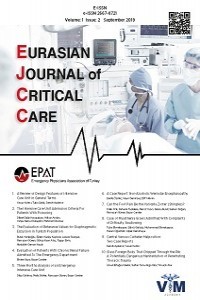Detection of Breath Alcohol After Oral Anti-Inflammatory Spray Use
Detection of Breath Alcohol After Oral Anti-Inflammatory Spray Use
emergency department, breath alcohol measurement, oral antiseptic spray, alcoholmeter, bady mass index,
___
- 1. Akgür SA, Ertas H, Altıntoprak AE, Ozkan M, Kitapcıoglu G: Prevalence of Alcohol in Blood Samples From Traffic Accident Cases in Turkey. Am J Forensic Med Pathol 2011,32: 136-9.
- 2. Uysal C, Karapirli M, Inanici MA: Effects of some of the regional Turkish fermented foods and medications on respiratory alcohol levels. Turk J Med Sci 2014, 44:720–27.
- 3. Foglio-Bonda PL, Poggia F, Foglio-Bonda A, Mantovani C, Pattarino F, Giglietta A. Determination of breath alcohol value after using mouthwashes containing ethanol in healthy young adults. Eur Rev Med Pharmacol Sci. 2015;19(14):2562-66.
- 4. Dasgupta A: Methods of alcohol measurement. Alcohol, Drugs, Genes and the Clinical Laboratory 2017, 155–66
- 5. European Medicines Agency: Committee for Medicinal Products for Human Use (CHMP). Information for the package leaflet regarding ethanol used as an excipient in medicinal products for human use. EMA/CHMP/43486/2018.
- 6. Karabulut D.Y, Özbunar E, Aydoğdu M, Akgür S.A Detection of Breath Alcohol After Using Personal Care Products Journal of Forensic Sciences and Criminal Research 2019 s.22-35
- 7. Hossain M, Jahan I, Akter S, Hasan MM., Uddin KR., Shawan MMAK., et al. Ethanol content in different energy drinks available in Bangladesh. Jahangirnagar University Journal of Biological Sciences 2017, 5(2): 57.
- 8. Wigmore JG, Leslie GM. The effect of swallowing or rinsing alcohol solution on the mouth alcohol effect and slope detection of the intoxilyzer 5000. J Anal Toxicol. 2001:25(2):112-14.
- 9. Fessler CC, Tulleners FA, Howitt DG, Richards JR. Determination of mouth alcohol using the Dräger Evidential Portable Alcohol System. Sci Justice. 2008;48:16-23.
- 10. Garcia JMI, Barrios JA, Iglesias CH. Influence of asthma inhalers on a breath alcohol test. Med Clin (Barc). 2002;118(9):332-4.
- 11. Official Gazette No. 26526 18/05/ 2007 Highway Traffic Regulation
- 12. Official Gazette No. 28918 19/02/2014- Highway Traffic Regulation
- Başlangıç: 2019
- Yayıncı: Acil Tıp Uzmanları Derneği
Pulmonary Embolism and COVID-19
Serhat ÖRÜN, Oğuzhan BOL, Ayhan AKÖZ
A Rare Injury Due to Blunt Trauma: Rupture of Subclavian Artery Branch
Cihad SÖNMEZ, Kasım TURGUT, Erdal YAVUZ, Umut GÜLAÇTI, Uğur LÖK, İrfan AYDIN
Özlem BİLİR, Alpaslan ÜNLÜ, Filiz TAŞÇI, Gökhan ERSUNAN, İsmail ATAŞ
A Rare Heart Valve Involvement in Adult Polycystic Kidney Disease: A Case Report
Murat DUYAN, Serhat GÜNLÜ, Ali SARIDAŞ, Basar CANDER, Yıldızhan SOLAÇ
Detection of Breath Alcohol After Oral Anti-Inflammatory Spray Use
Yeşim İŞLER, Halil KAYA, Melih YÜKSEL, Mehmet Oğuzhan AY, Mehtap BULUT
